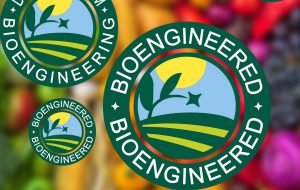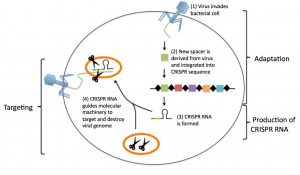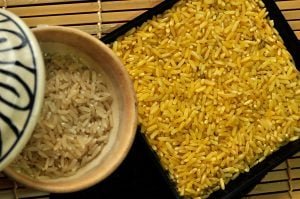You’ve probably heard terms like GMO, genetic engineering, genome editing, and selective breeding used to describe breeding crops. So it’s natural to ask questions about what these terms mean and what the science is behind the modern food system.
Here are some of the major ways that plants have been adapted and changed into the varieties, nutritional profile, taste, and appearance that we are familiar with today.
Traditional breeding
We’ve been modifying our food for nearly 10,000 years to suit our needs and tastes. Most of the food we eat today comes from traditional breeding methods that include selective breeding, crossbreeding, and mutation breeding. These methods produced many modern corn varieties and seedless watermelons.
- Selective breeding involves selecting plants or animals with particular characteristics (phenotypes) such as yield, size, growth, resistance, etc., and choosing which organisms should mate to produce offspring superior in the desired traits. These measurable phenotypes are a product of both the environment, genetics (DNA), and the interaction of the two.
- Crossbreeding involves the cross-pollination of two similar (yet distinct) plants to create a new plant with desired characteristics from the original plants.
- Mutation breeding has been used since the 1930s to speed up the natural mutation process in plants to produce more genetic variation. Mutations are not necessarily harmful. Many are neutral and some may be helpful, hence why this method is useful in plant breeding.
Genetic variation is like your vocabulary when writing a book. The more words you know, the more material you have to work with to select the desired combination. The more genetic variation we have to work with, the more material we have when selecting desired traits for our crops.
These processes can take many generations to make desirable changes and are not the most precise. Many genetic traits (genotypes) are linked together and may be incidentally changed, sometimes in a desirable way, other times in less desirable ways. Research has improved our knowledge of traditional breeding. Particularly, genomic selection allows us to use markers or SNPs (Single Nucleotide Polymorphisms, pronounced “snips”) of an organism’s DNA to optimize matings based on markers related to desirable traits and to minimize undesirable traits.
Transgenics — GMOs
As described by the U.S. Food and Drug Administration, a Genetically Modified Organism (GMO) is an organism, such as a plant, animal, or microbe that has had its DNA changed using recombinant DNA technology, or transgenics. This involves transferring a specific segment of DNA from one species to another. This could be from a different plant or totally different species altogether. This is possible, because all organisms share the common language of DNA to determine their traits.

Transgenes are inserted into plant cells via two methods. One is by coating a microscopic metal pellet with the transgene and shooting it at high speed into the plant cell, which in a small number of cases allows the gene to be incorporated into the plant cell’s genome.
The other method is by inserting the transgene into the soil-dwelling bacterium, Agrobacterium tumefaciens, which in nature infects plants by inserting its DNA into them, and using this tool from nature to insert the transgene into the plant cell. Genetic engineers disarm the bacteria, so that it can’t cause disease, but can still transfer DNA to plants. This method is more controlled than the microscopic metal pellets, but it doesn’t work well in all plant species. The plant cells that have taken up the transgene are identified, then cultured until they grow into a plant that can produce seeds. Scientists make sure the genes in these seeds are inherited in a normal way, the desired traits are expressed, and there are no negative effects on the plant.
Extensive and controlled research is done to ensure the safety of the product.
Transgenics allows scientists to take a useful gene such as drought or insect resistance from one organism and put it into a crop that doesn’t have this trait.
Most scientists consider “GMO” to be an imprecise term since virtually all of our crops have been “modified” for desirable traits in some way via the traditional methods covered above. More often, you’ll hear scientific communities using “genetically engineered” when speaking about non-traditional breeding approached.
Genome editing
The newest tool for crop genetics is genome editing. Genome editing refers to a new group of technologies that alter an organism’s DNA down to the single base-pair level. Where transgenics is like taking a page from one book and gluing it into another, genome editing is changing a word or even a letter to change the meaning of the sentence.
In this manner, a gene or part of a gene can be removed, added, or changed very precisely. Genome editing tools make genetic improvement much quicker and more precise than traditional methods.
Genome editing includes the CRISPR-Cas9 system, which can very precisely make genetic changes. In nature it’s a defense mechanism some bacteria use for protection to identify and remove foreign DNA inserted by a virus. Scientists have adapted this tool from nature to be able to target genes to edit by cutting and pasting the desired sequence into place. The “molecular scissors” are guided by guide RNA to the precise sequence they need to cut. This cut can either be repaired with the desired new sequence, or it can be left broken, which silences the gene.




Why genetically engineer crops?
Genetic engineering refers to laboratory-based technologies that alter the genetics of an organism, which includes transgenics and genome editing. It is another tool in the toolbox to improve the genetics of crops. It gives plant breeders much more specificity and takes significantly less time to make meaningful improvements.
Science use these techniques to improve the shelf life, resiliency, sustainability, and even the nutrition of crops.


Golden rice is an amazing example of a genetically engineered food — in which beta-carotene, which converts to vitamin A when digested, was added to this staple food. It’s extremely useful in developing countries that suffer from high incidences of vitamin A deficiency, which causes irreversible blindness in children.
Recently the label “bioengineered” has been added to some food packaging to indicate the food contains “detectable genetic material that has been modified through certain lab techniques and cannot be created through conventional breeding or found in nature.”
There are only 13 bioengineered foods available in the United States, many of which are animal feed crops.
There are a ton of myths and misconceptions about genetic engineering. Bioengineered foods go through a long, stringent, and detailed approval and monitoring process to ensure that they’re just as safe as their non-bioengineered counterparts.
You can find detailed GMO myth-busting lists here and here.
There’s a lot that goes into the breeding of crops. Ultimately the goal is to create crops that help affordably and sustainability feed people and animals. Each of these methods has its own pros and cons, and all have a place in agriculture.
Michelle Miller, the Farm Babe, is a farmer, public speaker and writer who has worked for years with row crops, beef cattle, and sheep. She believes education is key in bridging the gap between farmers and consumers.
(function(d, s, id) {
var js, fjs = d.getElementsByTagName(s)[0];
if (d.getElementById(id)) return;
js = d.createElement(s); js.id = id;
js.src = “//connect.facebook.net/en_US/sdk.js#xfbml=1&version=v2.8&appId=320025038337187”;
fjs.parentNode.insertBefore(js, fjs);
}(document, ‘script’, ‘facebook-jssdk’));
Source link




![[Podcast] Insights for Dealers about Case IH, Raven’s New Autonomous Spreader](../ext/resources/images/social-media/PFD-Podcast-logo.png)








